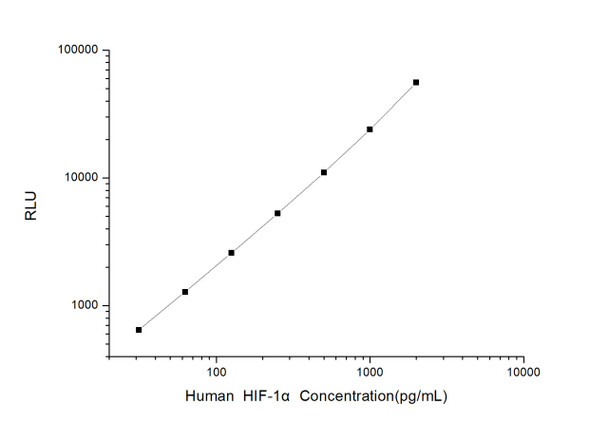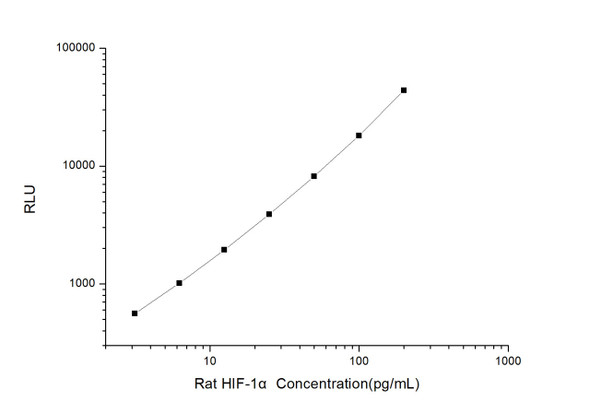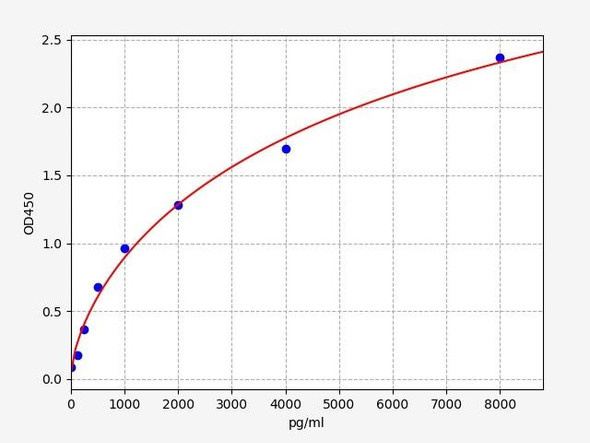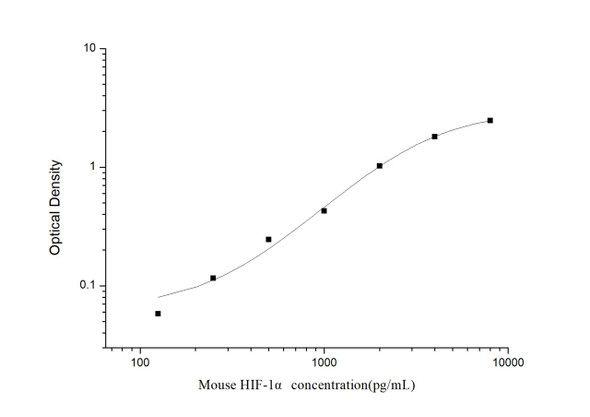Human Epigenetics and Nuclear Signaling ELISA Kits
Human HIF-1 alpha (Hypoxia Inducible Factor 1 Alpha) CLIA Kit (HUES00733)
- SKU:
- HUES00733
- Product Type:
- ELISA Kit
- ELISA Type:
- CLIA Kit
- Size:
- 96 Assays
- Sensitivity:
- 18.75pg/mL
- Range:
- 31.25-2000pg/mL
- ELISA Type:
- Sandwich
- Synonyms:
- HIF1A, HIF-1A, MOP1, PASD8, bHLHe78, basic helix-loop-helix transcription factor
- Reactivity:
- Human
- Sample Type:
- Serum, plasma and other biological fluids
- Research Area:
- Epigenetics and Nuclear Signaling
Description
| Assay type: | Sandwich |
| Format: | 96T |
| Assay time: | 4.5h |
| Reactivity: | Human |
| Detection method: | Chemiluminescence |
| Detection range: | 31.25-2000 pg/mL |
| Sensitivity: | 18.75 pg/mL |
| Sample volume: | 100µL |
| Sample type: | Tissue homogenates,cell lysates and other biological fluids |
| Repeatability: | CV < 15% |
| Specificity: | This kit recognizes Human HIF-1 alpha in samples. No significant cross-reactivity or interference between Human HIF-1 alpha and analogues was observed. |
This kit uses Sandwich-CLIA as the method. The micro CLIA plate provided in this kit has been pre-coated with an antibody specific to Human HIF-1 alpha. Standards or samples are added to the appropriate micro CLIA plate wells and combined with the specific antibody. Then a biotinylated detection antibody specific for Human HIF-1 alpha and Avidin-Horseradish Peroxidase (HRP) conjugate are added to each micro plate well successively and incubated. Free components are washed away. The substrate solution is added to each well. Only those wells that contain Human HIF-1 alpha, biotinylated detection antibody and Avidin-HRP conjugate will appear fluorescence. The Relative light unit (RLU) value is measured spectrophotometrically by the Chemiluminescence immunoassay analyzer. The RLU value is positively associated with the concentration of Human HIF-1 alpha. The concentration of Human HIF-1 alpha in the samples can be calculated by comparing the RLU of the samples to the standard curve.
| UniProt Protein Function: | HIF1A: a master transcriptional regulator of the adaptive response to hypoxia. Under hypoxic conditions, activates the transcription of over 40 genes, including erythropoietin, glucose transporters, glycolytic enzymes, vascular endothelial growth factor, HILPDA, and other genes whose protein products increase oxygen delivery or facilitate metabolic adaptation to hypoxia. Plays an essential role in embryonic vascularization, tumor angiogenesis and pathophysiology of ischemic disease. Binds to core DNA sequence 5'-[AG]CGTG-3' within the hypoxia response element (HRE) of target gene promoters. Activation requires recruitment of transcriptional coactivators such as CREBPB and EP300. Activity is enhanced by interaction with both, NCOA1 or NCOA2. Interaction with redox regulatory protein APEX seems to activate CTAD and potentiates activation by NCOA1 and CREBBP. Involved in the axonal distribution and transport of mitochondria in neurons during hypoxia. Interacts with the HIF1A beta/ARNT subunit; heterodimerization is required for DNA binding. Interacts with COPS5; the interaction increases the transcriptional activity of HIF1A through increased stability. Interacts with EP300 (via TAZ-type 1 domains); the interaction is stimulated in response to hypoxia and inhibited by CITED2. Interacts with CREBBP (via TAZ-type 1 domains). Interacts with NCOA1, NCOA2, APEX and HSP90. Interacts (hydroxylated within the ODD domain) with VHLL (via beta domain); the interaction, leads to polyubiquitination and subsequent HIF1A proteasomal degradation. During hypoxia, sumoylated HIF1A also binds VHL; the interaction promotes the ubiquitination of HIF1A. Interacts with SENP1; the interaction desumoylates HIF1A resulting in stabilization and activation of transcription. Interacts (Via the ODD domain) with ARD1A; the interaction appears not to acetylate HIF1A nor have any affect on protein stability, during hypoxia. Interacts with RWDD3; the interaction enhances HIF1A sumoylation. Interacts with TSGA10. Interacts with RORA (via the DNA binding domain); the interaction enhances HIF1A transcription under hypoxia through increasing protein stability. Interaction with PSMA7 inhibits the transactivation activity of HIF1A under both normoxic and hypoxia- mimicking conditions. Interacts with USP20. Interacts with RACK1; promotes HIF1A ubiquitination and proteasome- mediated degradation. Interacts (via N-terminus) with USP19. Under reduced oxygen tension. Induced also by various receptor-mediated factors such as growth factors, cytokines, and circulatory factors such as PDGF, EGF, FGF2, IGF2, TGFB1, HGF, TNF, IL1B, angiotensin-2 and thrombin. However, this induction is less intense than that stimulated by hypoxia. Repressed by HIPK2 and LIMD1. Expressed in most tissues with highest levels in kidney and heart. Overexpressed in the majority of common human cancers and their metastases, due to the presence of intratumoral hypoxia and as a result of mutations in genes encoding oncoproteins and tumor suppressors. 2 isoforms of the human protein are produced by alternative splicing. |
| UniProt Protein Details: | Protein type:Autophagy; DNA-binding; Transcription factor Chromosomal Location of Human Ortholog: 14q23. 2 Cellular Component: nucleoplasm; transcription factor complex; cytoplasm; nucleolus; nuclear speck; cytosol; nucleus Molecular Function:RNA polymerase II transcription factor activity, enhancer binding; histone deacetylase binding; Hsp90 protein binding; transcription factor binding; protein kinase binding; histone acetyltransferase binding; protein binding; signal transducer activity; enzyme binding; protein heterodimerization activity; sequence-specific DNA binding; ubiquitin protein ligase binding; transcription factor activity; nuclear hormone receptor binding Biological Process: lactation; oxygen homeostasis; embryonic placenta development; response to muscle activity; cellular iron ion homeostasis; positive regulation of transcription, DNA-dependent; glucose homeostasis; signal transduction; positive regulation of vascular endothelial growth factor receptor signaling pathway; muscle maintenance; negative regulation of bone mineralization; connective tissue replacement during inflammatory response; elastin metabolic process; axon transport of mitochondrion; regulation of transcription, DNA-dependent; visual learning; heart looping; angiogenesis; regulation of transcription from RNA polymerase II promoter in response to oxidative stress; neural crest cell migration; negative regulation of growth; hemoglobin biosynthetic process; positive regulation of neuroblast proliferation; negative regulation of TOR signaling pathway; regulation of transforming growth factor-beta2 production; Notch signaling pathway; collagen metabolic process; embryonic hemopoiesis; positive regulation of nitric-oxide synthase activity; positive regulation of erythrocyte differentiation; B-1 B cell homeostasis; digestive tract morphogenesis; mRNA transcription from RNA polymerase II promoter; positive regulation of chemokine production; positive regulation of angiogenesis; neural fold elevation formation; regulation of gene expression; positive regulation of hormone biosynthetic process; cartilage development; positive regulation of glycolysis; lactate metabolic process; response to hypoxia; epithelial to mesenchymal transition; positive regulation of transcription from RNA polymerase II promoter; positive regulation of endothelial cell proliferation; cerebral cortex development |
| NCBI Summary: | This gene encodes the alpha subunit of transcription factor hypoxia-inducible factor-1 (HIF-1), which is a heterodimer composed of an alpha and a beta subunit. HIF-1 functions as a master regulator of cellular and systemic homeostatic response to hypoxia by activating transcription of many genes, including those involved in energy metabolism, angiogenesis, apoptosis, and other genes whose protein products increase oxygen delivery or facilitate metabolic adaptation to hypoxia. HIF-1 thus plays an essential role in embryonic vascularization, tumor angiogenesis and pathophysiology of ischemic disease. Alternatively spliced transcript variants encoding different isoforms have been identified for this gene. [provided by RefSeq, Jul 2011] |
| UniProt Code: | Q16665 |
| NCBI GenInfo Identifier: | 2498017 |
| NCBI Gene ID: | 3091 |
| NCBI Accession: | Q16665. 1 |
| UniProt Secondary Accession: | Q16665,Q53XP6, Q96PT9, Q9UPB1, C0LZJ3, |
| UniProt Related Accession: | Q16665 |
| Molecular Weight: | 95,634 Da |
| NCBI Full Name: | Hypoxia-inducible factor 1-alpha |
| NCBI Synonym Full Names: | hypoxia inducible factor 1, alpha subunit (basic helix-loop-helix transcription factor) |
| NCBI Official Symbol: | HIF1A |
| NCBI Official Synonym Symbols: | HIF1; MOP1; PASD8; HIF-1A; bHLHe78; HIF-1alpha; HIF1-ALPHA |
| NCBI Protein Information: | hypoxia-inducible factor 1-alpha; ARNT interacting protein; ARNT-interacting protein; HIF-1-alpha; PAS domain-containing protein 8; basic-helix-loop-helix-PAS protein MOP1; class E basic helix-loop-helix protein 78; hypoxia-inducible factor 1 alpha isoform I. 3; hypoxia-inducible factor 1, alpha subunit (basic helix-loop-helix transcription factor); hypoxia-inducible factor1alpha; member of PAS protein 1; member of PAS superfamily 1 |
| UniProt Protein Name: | Hypoxia-inducible factor 1-alpha |
| UniProt Synonym Protein Names: | ARNT-interacting protein; Basic-helix-loop-helix-PAS protein MOP1; Class E basic helix-loop-helix protein 78; bHLHe78; Member of PAS protein 1; PAS domain-containing protein 8 |
| Protein Family: | Hypoxia-inducible factor |
| UniProt Gene Name: | HIF1A |
| UniProt Entry Name: | HIF1A_HUMAN |
As the RLU values of the standard curve may vary according to the conditions of the actual assay performance (e. g. operator, pipetting technique, washing technique or temperature effects), the operator should establish a standard curve for each test. Typical standard curve and data is provided below for reference only.
| Concentration (pg/mL) | RLU | Average | Corrected |
| 2000 | 51175 60267 | 55721 | 55693 |
| 1000 | 22155 25793 | 23974 | 23946 |
| 500 | 11883 10181 | 11032 | 11004 |
| 250 | 5264 5324 | 5294 | 5266 |
| 125 | 2706 2510 | 2608 | 2580 |
| 62.5 | 1414 1208 | 1311 | 1283 |
| 31.25 | 641 707 | 674 | 646 |
| 0 | 27 29 | 28 | -- |
Precision
Intra-assay Precision (Precision within an assay): 3 samples with low, mid range and high level Human HIF-1 alpha were tested 20 times on one plate, respectively.
Inter-assay Precision (Precision between assays): 3 samples with low, mid range and high level Human HIF-1 alpha were tested on 3 different plates, 20 replicates in each plate.
| Intra-assay Precision | Inter-assay Precision | |||||
| Sample | 1 | 2 | 3 | 1 | 2 | 3 |
| n | 20 | 20 | 20 | 20 | 20 | 20 |
| Mean (pg/mL) | 107.08 | 299.65 | 789.01 | 97.83 | 321.72 | 833.58 |
| Standard deviation | 10.63 | 32.51 | 49.31 | 9.71 | 22.55 | 65.27 |
| C V (%) | 9.93 | 10.85 | 6.25 | 9.93 | 7.01 | 7.83 |
Recovery
The recovery of Human HIF-1 alpha spiked at three different levels in samples throughout the range of the assay was evaluated in various matrices.
| Sample Type | Range (%) | Average Recovery (%) |
| Serum (n=5) | 93-107 | 100 |
| EDTA plasma (n=5) | 87-101 | 94 |
| Cell culture media (n=5) | 85-96 | 91 |
Linearity
Samples were spiked with high concentrations of Human HIF-1 alpha and diluted with Reference Standard & Sample Diluent to produce samples with values within the range of the assay.
| Serum (n=5) | EDTA plasma (n=5) | Cell culture media (n=5) | ||
| 1:2 | Range (%) | 102-119 | 91-103 | 102-118 |
| Average (%) | 110 | 97 | 110 | |
| 1:4 | Range (%) | 85-98 | 90-104 | 86-97 |
| Average (%) | 91 | 96 | 91 | |
| 1:8 | Range (%) | 86-100 | 84-96 | 91-102 |
| Average (%) | 91 | 90 | 97 | |
| 1:16 | Range (%) | 95-109 | 94-107 | 85-99 |
| Average (%) | 101 | 101 | 92 |
An unopened kit can be stored at 4°C for 1 month. If the kit is not used within 1 month, store the items separately according to the following conditions once the kit is received.
| Item | Specifications | Storage |
| Micro CLIA Plate(Dismountable) | 8 wells ×12 strips | -20°C, 6 months |
| Reference Standard | 2 vials | |
| Concentrated Biotinylated Detection Ab (100×) | 1 vial, 120 µL | |
| Concentrated HRP Conjugate (100×) | 1 vial, 120 µL | -20°C(shading light), 6 months |
| Reference Standard & Sample Diluent | 1 vial, 20 mL | 4°C, 6 months |
| Biotinylated Detection Ab Diluent | 1 vial, 14 mL | |
| HRP Conjugate Diluent | 1 vial, 14 mL | |
| Concentrated Wash Buffer (25×) | 1 vial, 30 mL | |
| Substrate Reagent A | 1 vial, 5 mL | 4°C (shading light) |
| Substrate Reagent B | 1 vial, 5 mL | 4°C (shading light) |
| Plate Sealer | 5 pieces | |
| Product Description | 1 copy | |
| Certificate of Analysis | 1 copy |
- Set standard, test sample and control (zero) wells on the pre-coated plate and record theirpositions. It is recommended to measure each standard and sample in duplicate. Note: addall solutions to the bottom of the plate wells while avoiding contact with the well walls. Ensuresolutions do not foam when adding to the wells.
- Aliquot 100µl of standard solutions into the standard wells.
- Add 100µl of Sample / Standard dilution buffer into the control (zero) well.
- Add 100µl of properly diluted sample (serum, plasma, tissue homogenates and otherbiological fluids. ) into test sample wells.
- Cover the plate with the sealer provided in the kit and incubate for 90 min at 37°C.
- Aspirate the liquid from each well, do not wash. Immediately add 100µL of BiotinylatedDetection Ab working solution to each well. Cover the plate with a plate seal and gently mix. Incubate for 1 hour at 37°C.
- Aspirate or decant the solution from the plate and add 350µL of wash buffer to each welland incubate for 1-2 minutes at room temperature. Aspirate the solution from each well andclap the plate on absorbent filter paper to dry. Repeat this process 3 times. Note: a microplatewasher can be used in this step and other wash steps.
- Add 100µL of HRP Conjugate working solution to each well. Cover with a plate seal andincubate for 30 min at 37°C.
- Aspirate or decant the solution from each well. Repeat the wash process for five times asconducted in step 7.
- Add 100µL of Substrate mixture solution to each well. Cover with a new plate seal andincubate for no more than 5 min at 37°C. Protect the plate from light.
- Determine the RLU value of each well immediately.






